We’ve all had some time to digest the details of the new Aeroplan loyalty program that were announced this week, and in this post I’d like to share my picks for the winners and losers from the transition to the new Aeroplan.
Who are the greatest beneficiaries from the new program? And who can feel the most hard done by – and would therefore need to adapt their strategy the most in order to avoid falling behind?
Let’s look across the board – across the new flight rewards, credit cards, program features, Elite Status, complex routings, and flight earning structure – to identify which groups of travellers have the most to gain or lose.
In This Post
- Winner – Western Canadians
- Winner – The Average Traveller
- Winner – Families
- Winner – Aspirational Travellers & Aviation Geeks
- Winner – Aeroplan Credit Card Holders
- Winner – Aeroplan 35K, 50K, and 75K
- Winner – Domestic Basic & Standard + High-Yield Paid Fares
- Loser – Atlantic Canadians
- Loser – Travellers Based Outside of Major Cities
- Loser – Intercontinental Economy Class
- Loser – Aeroplan 25K & Super Elite
- Loser – Lower-Yield Paid Fares
- Loser – Inflexible Travellers
- Conclusion
Winner – Western Canadians
With the change in the award charts, every region of Canada received its own small sprinkling of new sweet spots – redemptions that will be cheaper than before – amidst a broad-based devaluation in which the majority of awards will be going up in price.
However, if there were one region in Canada that has received the lion’s share of new sweet spots, it’d be Western Canada – Vancouver and Victoria in particular, but including Calgary as well.
Why? As we’ve covered in our Old vs. New award comparison chart, Vancouverites will enjoy some pretty sweet discounts on certain premium routes to the Asia-Pacific compared to now:
- Vancouver–Tokyo or Calgary–Tokyo for 35,000 or 55,000 Aeroplan points in economy or business, respectively, compared to 37,500 or 75,000 Aeroplan miles currently
- Vancouver–San Francisco–Pape’ete for 35,000 or 55,000 Aeroplan points in economy or business, respectively, compared to 40,000 or 80,000 Aeroplan miles currently
- Vancouver–Auckland or Calgary–Vancouver–Auckland for 75,000 Aeroplan points in business class, compared to 80,000 Aeroplan miles currently
- Vancouver–Brisbane for 75,000 Aeroplan points in business class, compared to 80,000 Aeroplan miles currently
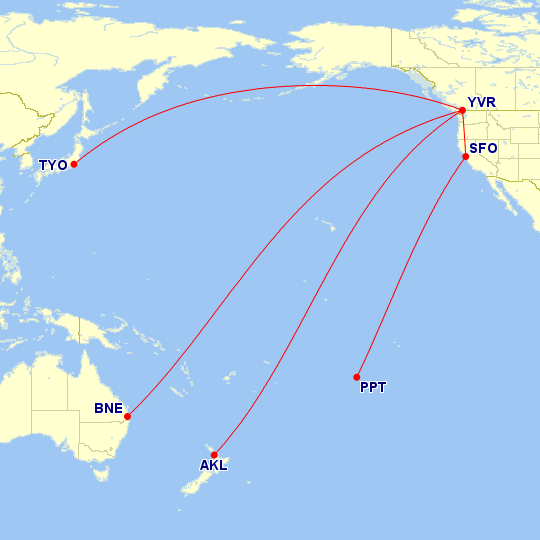
Don’t get me wrong, Western Canadians are definitely still impacted by the overall devaluation, especially if their travel preferences favour Europe (or the Atlantic zone) instead of Asia (or the Pacific zone).
However, relative to the rest of Canada, I think it’s safe to say our Western residents are coming out ahead the most in terms of attractive new redemption opportunities.
Winner – The Average Traveller
I’d say the new Aeroplan program is pretty clearly designed to do a better job of catering towards the “average” Canadian traveller, who might go on one or two vacations per year with their families, but otherwise doesn’t necessarily prioritize frequent travel as part of their lives.
Many of the changes point towards this:
- No matter where in Canada you’re based, redemptions to “Sun destinations” like Mexico, Central America, and the Caribbean, as well as Hawaii – all of which are popular destinations among infrequent leisure travellers – will now be cheaper than they were before.
- The elimination of fuel surcharges on Air Canada, and key partners with ample availability like Lufthansa, means that Aeroplan members can choose direct flights for their trip and no longer have to sacrifice their precious vacation time making detours on surcharge-free airlines.
- Last-seat availability on Air Canada flights will now be redeemable with Aeroplan points, giving infrequent travellers the option to pay more for their desired flights if they want, even during peak travel season; previously, these flights may not have been bookable at all, leaving members with only a set of very inconvenient flight options.
While the “average” Canadian traveller probably won’t be satisfied with their outcomes every single time, I’d say that, on balance, the new Aeroplan seems likely to deliver more value to the occasional vacationer than it did before – when Aeroplan’s flight options were frequently unavailable, nonsensical, or over-expensive due to surcharges, driving members away to other rewards programs.
Winner – Families
On a similar note, Aeroplan members who earn and redeem points as a family obviously will stand to benefit from the new Family Sharing feature.
While much has been made about the possibilities of maximizing Family Sharing among savvy Miles & Points enthusiasts, this feature will also make the program significantly more straightforward and user-friendly for most Canadian families.
Think about a family of four who’s flying on a paid fare and crediting each family member’s flight to their own Aeroplan account. Each person’s balance can take years to accrue to a meaningful amount, whereas now they’ll be able to unlock a redemption possibility four times quicker.
Moreover, when signing up for co-branded credit cards, most families out there expect to be able to pool their points together, and are somewhat surprised when they find out that many loyalty programs don’t allow this.
To accomplish this in the past, you’d have to surreptitiously add your partner’s Aeroplan number to your co-branded credit card, or constantly link and unlink your partner’s Aeroplan account to your Amex MR account. Family Sharing abolishes the need for these backdoor strategies.
Winner – Aspirational Travellers & Aviation Geeks
I think the community of “aspirational travellers” – those of us who are most interested in using Miles & Points to unlock unique and luxurious travel experiences that they’d never pay cash for – stand to benefit more than they stand to lose from the new program.
I’d also include “aviation geeks”, or people who simply love to fly and usually prefer to do so in comfort, in this assessment as well.
Yes, the steep hike in award chart prices will hurt on most redemptions. However, as an aspirational traveller myself and among others who identify similarly, I’ve observed that we mostly focus on the prize rather than the cost.
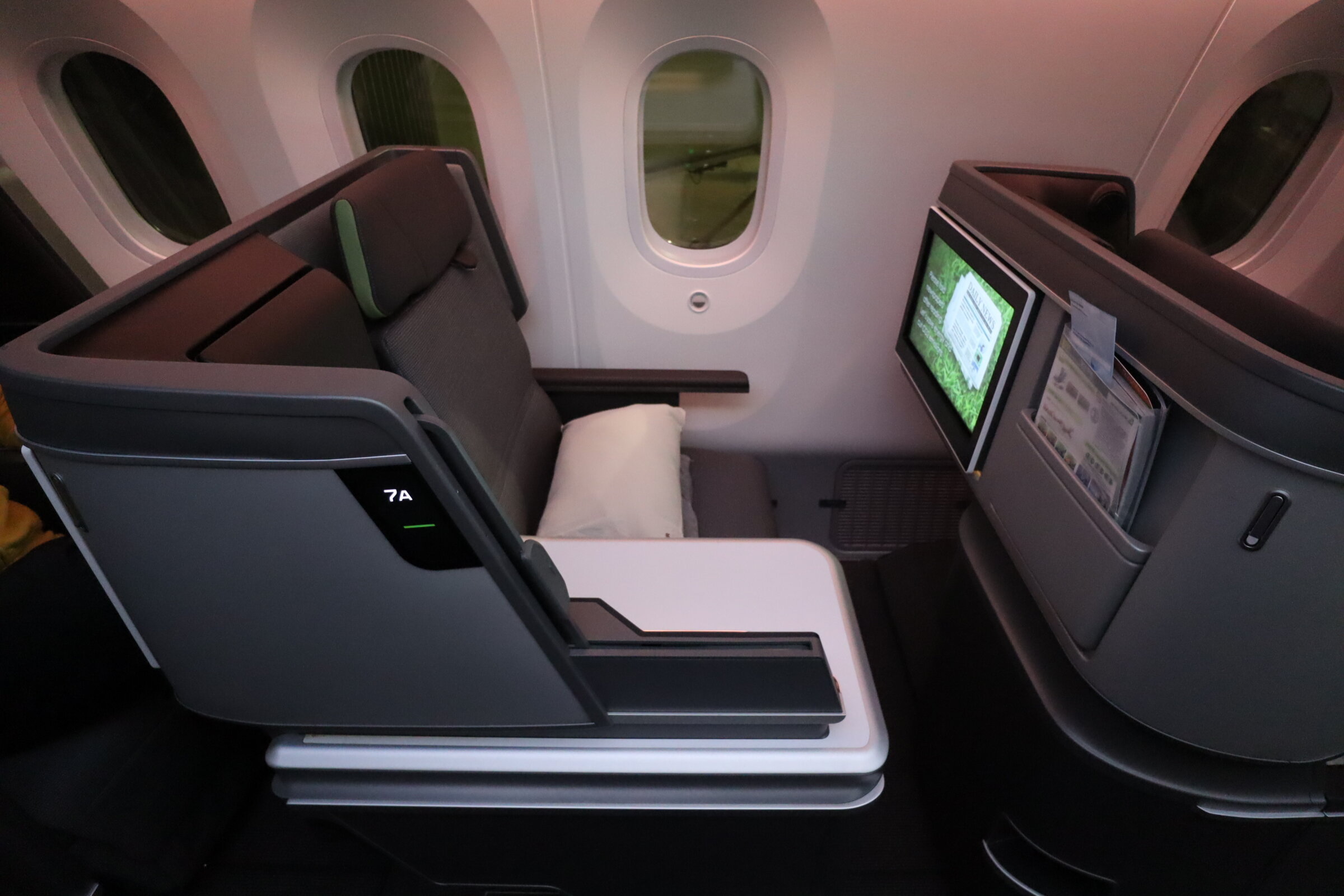
Toronto–Taipei on EVA Air business class may increase from 75,000 Aeroplan miles to 85,000 Aeroplan points (quite agonizingly too, at 7,519 miles in distance, only 19 miles above the threshold); however, both of those price points are still infinitely better than paying $7,000 for the ticket.
Of course, if that were the end of the analysis, then we aspirational travellers would still be a Loser in this situation. What makes us a Winner here is the sheer generosity of the ability to add a stopover on a one-way flight for 5,000 Aeroplan points, as well as the expanded range of routing possibilities under the new program.
I don’t know about you, but I simply cannot wait to book stopovers on one-ways, such as stopping in Australia on the way to Asia, stopping in Africa on the way to India, or even stopping on a cheap intra-Asia award to add another dimension to my trip – all for an incremental 5,000 Aeroplan points.
Other than the new Aeroplan, the only other rewards program to offer us this level of flexibility are Alaska Mileage Plan and, until they changed their policy in April 2020, Cathay Pacific Asia Miles.
However, the former would only allow you to combine Alaska metal with one partner, while the latter restricted a one-way to a very impractical limit of only two segments.
With the new Aeroplan, we’ll have the entire Star Alliance route network to play with, in addition to partner airlines like Etihad Airways, Azul, and potentially even more partners as well. Many exciting globetrotting possibilities await.
Winner – Aeroplan Credit Card Holders
This one is a very tight call, but I think that current holders of the core, premium, and small business Aeroplan co-branded credit cards are just about winning.
TD and CIBC’s core and premium credit cards’ annual fees will be rising by $19 and $200, respectively. In the case of the core cards, I think the Air Canada free first checked bag benefit (which will no longer be limited to Aeroplan reward tickets) is one that most cardholders will find value in, which should justify the annual fee increase after a single use.
A few other benefits are going away, but those are also offset by a stronger insurance package, and in the TD Aeroplan Visa Infinite’s case, a $100 NEXUS credit as well.
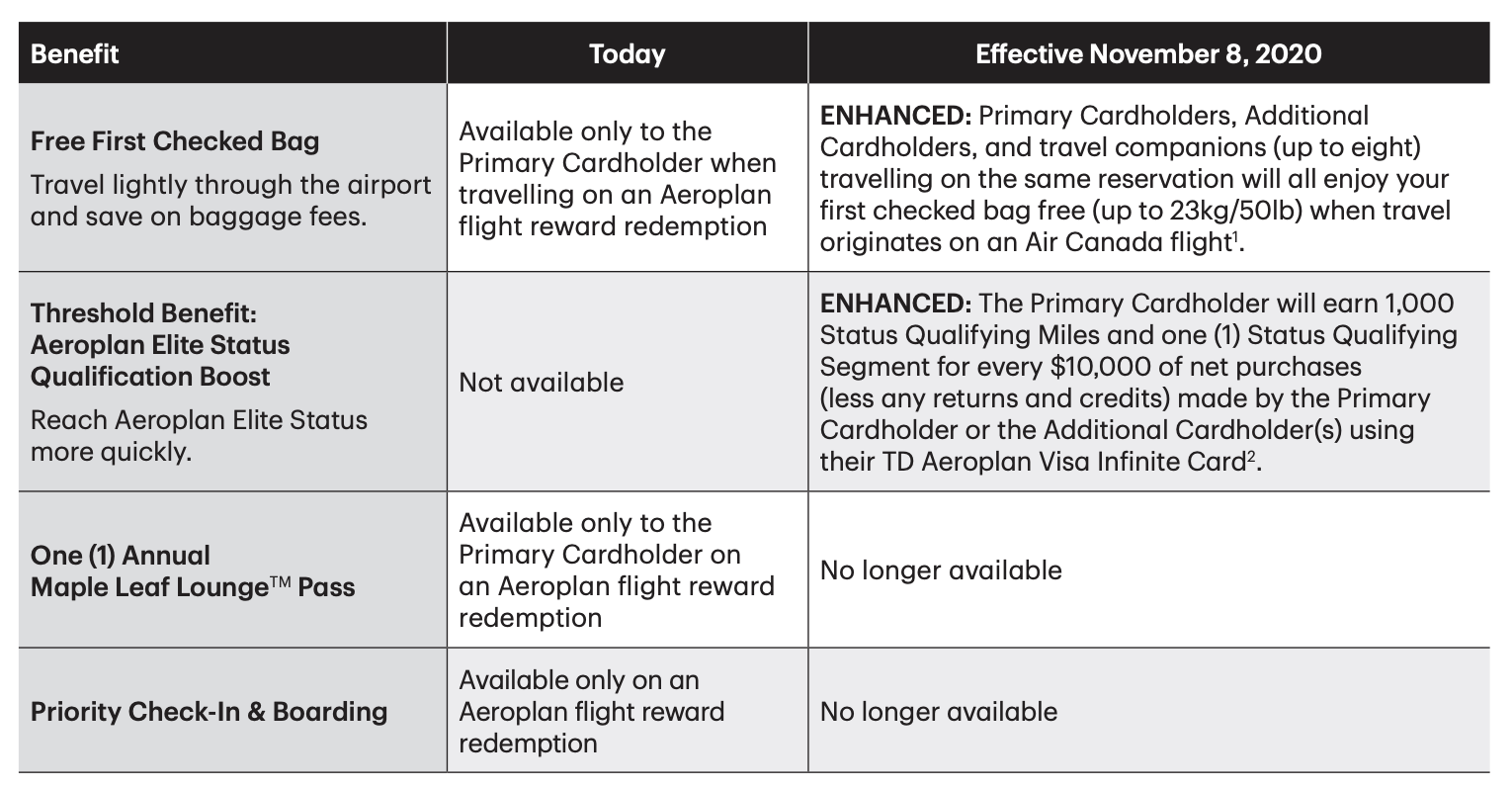
The changes to the premium cards’ benefits are more wide-ranging, and it’s honestly a bit of a mixed bag.
For example, replacing the previous 50% companion ticket in business class with an economy class companion voucher that’s tied to $25,000 in annual spending seems to be a decidedly negative change in my view.
I think the most significant determinant to whether the $200 increase in annual fee is justified is how much you value the unlimited Maple Leaf Lounge access and the six Priority Pass lounge visits.
For some travellers, this will easily persuade them into holding the card in the long term even at a $599 price point, while others may feel differently.
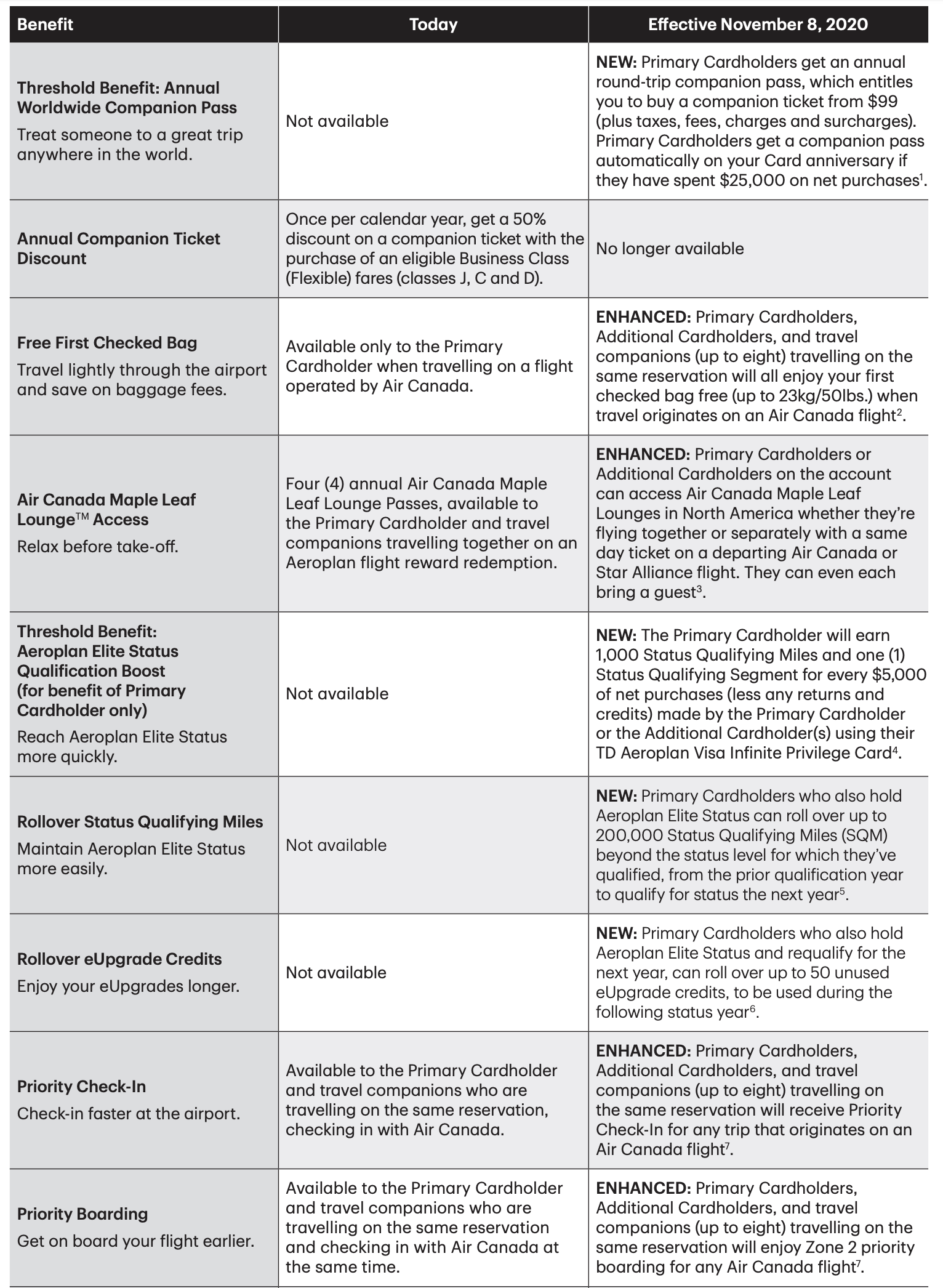
The small business credit cards aren’t increasing in fee, and their change in benefits is also a bit of a wash.
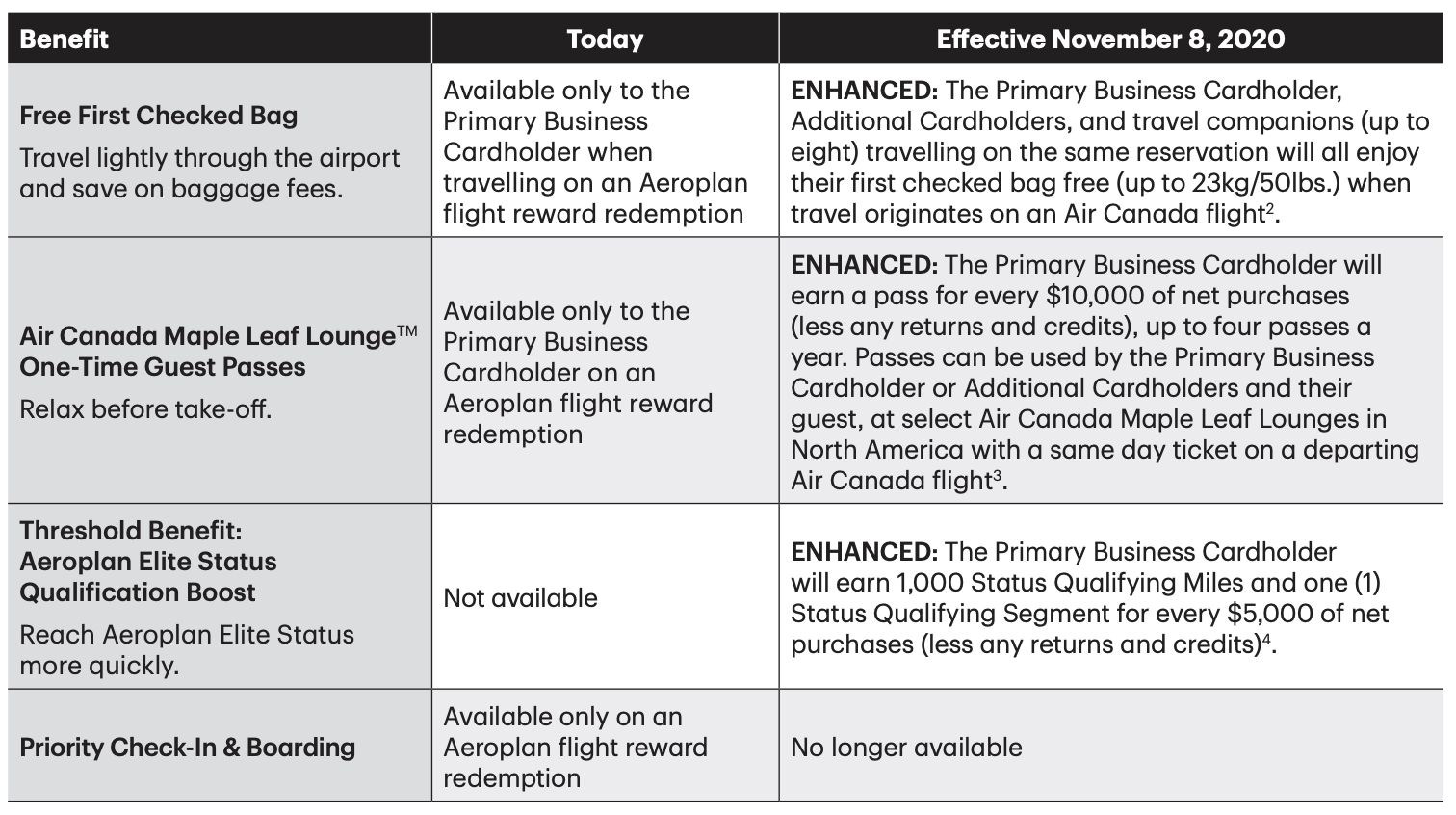
(American Express will release more information about how their cards are changing, as well as their brand-new Aeroplan Business Reserve product, later this month. We’ll be able to assess those products more closely by then.)
Overall, I think the ability to share benefits with authorized users, as well as the preferred pricing on Air Canada flights as a credit card holder, gives the value proposition a boost in all three segments.
That’s why I’m calling current cardholders a Winner, although it could easily be different for individual cardholders who don’t place a high value on the new perks.
And obviously, one of the most highly-anticipated details about the new Aeroplan credit cards is the welcome bonus, which promises to be very impressive. Current cardholders may therefore wish to temporarily relinquish their cardholder status if they want to become even more of a Winner. 😉
Winner – Aeroplan 35K, 50K, and 75K
Aeroplan Elite Status will replace Air Canada Altitude, but there are relatively few changes planned to the qualification criteria and elite privileges.
Among these changes, I think Aeroplan 35K, 50K, and 75K – the “mid-tier elites” – are coming out ahead.

For Aeroplan 35K members, the only meaningful change is the improved value of the new Priority Rewards.
Currently, Altitude Elite 35K members only get Priority Rewards that allow them to access last-seat economy class space at double the usual price; outside of last-minute emergency situations, Elite 35K members rarely seem to find value in this benefit.
Going forward, however, the Priority Rewards will be much more meaningful, allowing Elite 35K members – who are guaranteed to earn at least one Priority Reward per year by meeting the Status Qualifying Dollars (SQD) threshold of $4,000 – to save 50% of the award cost on an economy class flight within Canada and the US. Redeemed wisely, that can be worth up to 35,000 Aeroplan points alone.
Aeroplan 50K and 75K members will likewise benefit in the same way, as the new Priority Rewards (of which 50K members are guaranteed to earn at least one, and 75K members at least two) will deliver far more value than before.
And on top of that, 50K and 75K members also further benefit from the new Status Pass as well, allowing them to give the gift of their status perks on a loved one’s journey, which is a benefit that I’m sure many hard-earned Elite Status members will appreciate.
Winner – Domestic Basic & Standard + High-Yield Paid Fares
Later in 2021, Air Canada will change the way that Aeroplan points are awarded on paid Air Canada-issued tickets. Instead of the current distance-based model, the program will move towards a revenue-based model that calculates your points earnings based on the fare you paid.
As a reminder, below are the two charts for the earning multipliers based on your underlying fare class and your Elite Status. Add the two multipliers together and apply that against your fare to calculate how many Aeroplan points you’ll earn.
Fare Family | Earning Multiplier |
Basic | 2x |
Standard, Flex/Comfort, Latitude, | 3x |
Aeroplan Elite Status | Earning Multiplier |
25K, 35K | 1x |
50K | 2x |
75K | 3x |
Super Elite | 4x |
A move to a revenue-based earning model is generally bad news, although there are a small handful of winners that emerge from this change:
- Those who usually book Basic Economy fares will go from earning zero Aeroplan miles to earning at least 2x Aeroplan points on their fare (this change has already been implemented as of August 11, 2020).
- Those who usually book domestic Standard fares will go from earning 25% Aeroplan miles based on distance to earning at least 3x Aeroplan points on their fare, which may end up netting a higher amount.
- Those who usually book short-haul flights may not have earned many Aeroplan miles at all under the distance-based model, and may find themselves coming out ahead under the fare-based model.
- Those who have high-tier Elite Status and book expensive long-haul business class flights (or rather, those whose companies gladly pay for these flights) may end up earning more Aeroplan miles, because they are the clientele that the new revenue-based system is intended to reward.
Loser – Atlantic Canadians
Now let’s talk about the Losers.
While Western Canadians were the clear Winners among the Canadian regions in terms of new redemption sweet spots, I think it’s fair to say that Atlantic Canada is getting the short end of the stick.
Part of this is purely situational, due to the fact that Air Canada’s route network within the region, as well as the direct flights from Halifax and St. John’s to London Heathrow, have been suspended indefinitely due to a combination of the Boeing 737 MAX groundings and COVID-19.
On paper, St. John’sers (St. John’sans?) looking to fly transatlantic would be well-positioned to take advantage of the new hybrid distance-based chart given their geographical proximity to Europe. However, because of the decimated route network, they are penalized instead, as they now need to double-back to Montreal or Toronto in order to fly to Europe.
Hopefully these shorter transatlantic routes will be restored sooner rather than later, so that Atlantic Canadians can benefit from their own sweet spots too. For example, St. John’s–London–Istanbul clocks in just under the first threshold of 4,000 miles on the North America–Atlantic chart, making it the only Canadian city from which you could fly to Turkey for 60,000 Aeroplan points in business class.
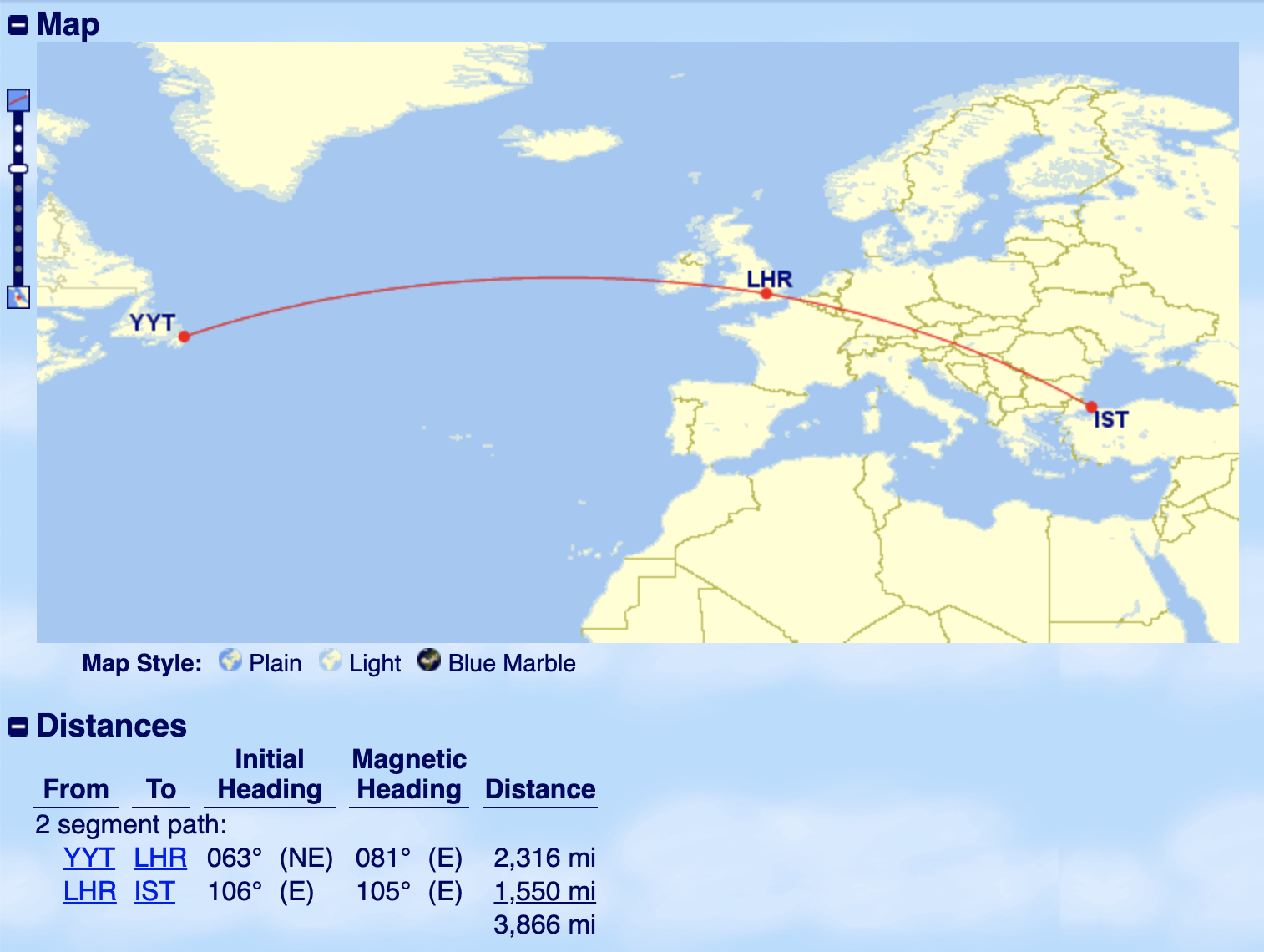
Until then, however, they can certainly feel a little hard done by.
Loser – Travellers Based Outside of Major Cities
On a similar theme, the new flight rewards structure penalizes those who are based outside of major cities (i.e., Toronto, Montreal, Vancouver, Calgary, and to a lesser extent Ottawa, Edmonton, and Halifax).
These travellers will always have to add that first and last flight to a major hub before and after catching an international flight. In the past, this did not change the award cost and the only consideration was maximum permitted mileage (MPM), whereas nowadays that “last mile” flight will always add to their distance totals and potentially bump them up to the next distance band.
This inconvenience may be potentially offset by the fact that Aeroplan points can now access last-seat availability on Air Canada, which means that you’ll no longer have a situation in which you’ve planned an awesome round-the-world trip but can’t find any award space on that last domestic Air Canada flight to get you home.
Of course, the flip-side to this is that you’ll pay more Aeroplan points for these last-seat availability situations, thanks to the weighted-averaged pricing model for mixed itineraries between Air Canada and partner flights.
So while non-hub-based travellers may benefit from the additional access to Air Canada seats on their “last mile” flights, that doesn’t change the fact that those last-mile flights may be punitive for them in terms of the new distance-based charts, compared to before.
Loser – Intercontinental Economy Class Travellers
While the overall award chart devaluation is pretty ugly across the board, I think it’s especially punitive for Aeroplan members who prefer to redeem points for intercontinental economy class travel.
Of the 17 transatlantic, transpacific, or trans-Americas destinations that we had surveyed in our Old vs. New award comparison chart, 16 of them witnessed devaluations from at least two of the four Canadian points of origin. And among these 16, a staggering 13 of them witnessed a greater percentage increase in the pricing for economy class compared to business class.
Some of the new economy class price points don’t even make any sense. For example, a flight from Vancouver to Dubai will now cost at least 140,000 Aeroplan points round-trip in economy class, once you factor in the necessary connections (outside of the rare scenarios when the Air Canada flights can be priced lower than the published ranges).
With economy class cash fares regularly available for $1,000–1,200 round-trip, what type of person will want to redeem Aeroplan points on this route? Previously, the value in redeeming Aeroplan miles for international economy was already limited; now, it’s even more strained than before.
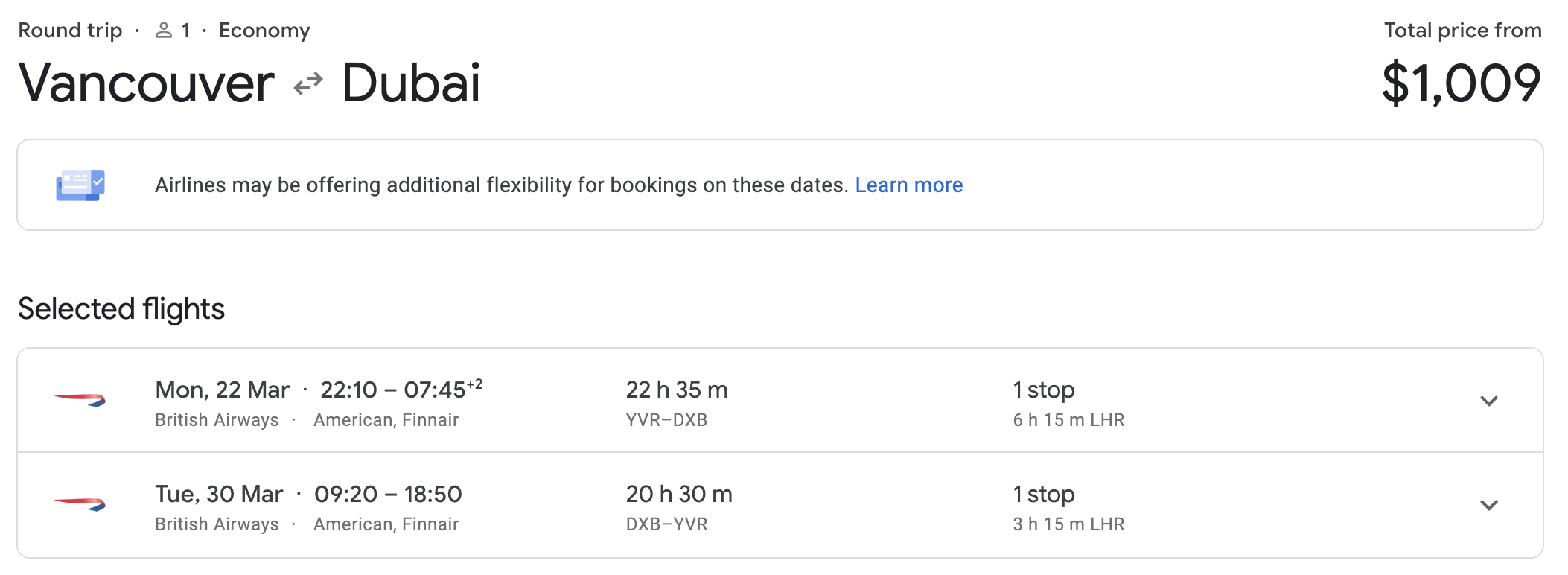
Going forward, economy class flyers may well be tempted to look towards other rewards programs or to hunt for cheap cash fares instead.
Some might be willing to save their Aeroplan points for domestic travel or redeem them on the occasional splurge in business class, but I do imagine that most international economy class travellers will be very unhappy with how the chips have fallen for them in the new program.
Loser – Aeroplan 25K & Super Elite
While the new Priority Rewards and Status Pass benefits serve to improve the Aeroplan Elite Status program on the whole, I do feel that the members on either end of the extreme – Aeroplan 25K members and Super Elite members – might not feel very satisfied about where their particular status tiers are headed.
Aeroplan 25K status is shaping up to be a status level that gets handed out very generously (at least for this year and next year), through things like Everyday Status Qualification, the grandfathering of legacy Aeroplan Diamond, Black, and Silver status, and the Travel at Home promotion earlier this year.
Perhaps because of how easy it is to earn Aeroplan 25K, these members also aren’t getting any Priority Rewards unless they earn them through SQD activity. Furthermore, one of the most valuable benefits of 25K was the surcharge waiver on North American flights, but now that all surcharges will be eliminated, that’s moot too.
On paper, Aeroplan 25K members haven’t lost anything, so I’m placing them in this category only as a borderline edge case. They may feel that their benefits have been diluted, but then again, they’ll certainly benefit from preferred pricing on Air Canada flights as an Elite Status member in the new program.
Now let’s talk about Aeroplan Super Elite members. I get the sense that Super Elites are the least satisfied with the new Aeroplan Elite Status among the bunch.

Why? Well, although the old Priority Rewards were not very useful for 35K, 50K, and 75K members, they were extremely useful for Super Elites.
Unlike the riff-raff in the lower tiers, Super Elites could redeem miles for last-seat availability in economy class at the standard rate, rather than double the standard rate.
Furthermore, Super Elites could access a much wider range of Air Canada business class reward space, making up to 10 bookings per year using this special expanded set of award space. And it’s my understanding that each of these bookings could’ve included up to nine passengers.
Now compare that to today’s Priority Rewards – yes, Super Elites get 50% off business class awards with Aeroplan, but your average Super Elite member will only earn five Priority Rewards per year from meeting the SQD threshold of $20,000, and each Priority Reward can only be redeemed for a single passenger. I can easily see why Super Elites might prefer the old Priority Rewards to the new.
There are a few other angles to Super Elites’ dissatisfaction: with all surcharges being phased out, their unique benefit of a surcharge waiver on international Air Canada flights is now moot. And lastly, there’s the fact that Super Elites who qualify on Status Qualifying Segments (SQS) will have their SQS requirement raised from 95 to 100.
Don’t get me wrong, I’m sure that both Aeroplan 25K and Super Elites will continue to derive good value out of their Aeroplan Elite Status, but I feel that they’ve both been left expecting something more from the new elite program.
Loser – Lower-Yield Paid Fares
Outside of the few specific cases that we mentioned in the Winners section, most travellers who book paid fares with Air Canada will end up earning fewer Aeroplan points than before under the revenue-based earning model.
For example, consider a simple Toronto–Vancouver round-trip booked in Flex. Under the current mileage-based earning, this would earn a full 4,169 Aeroplan miles based on the distance flown.
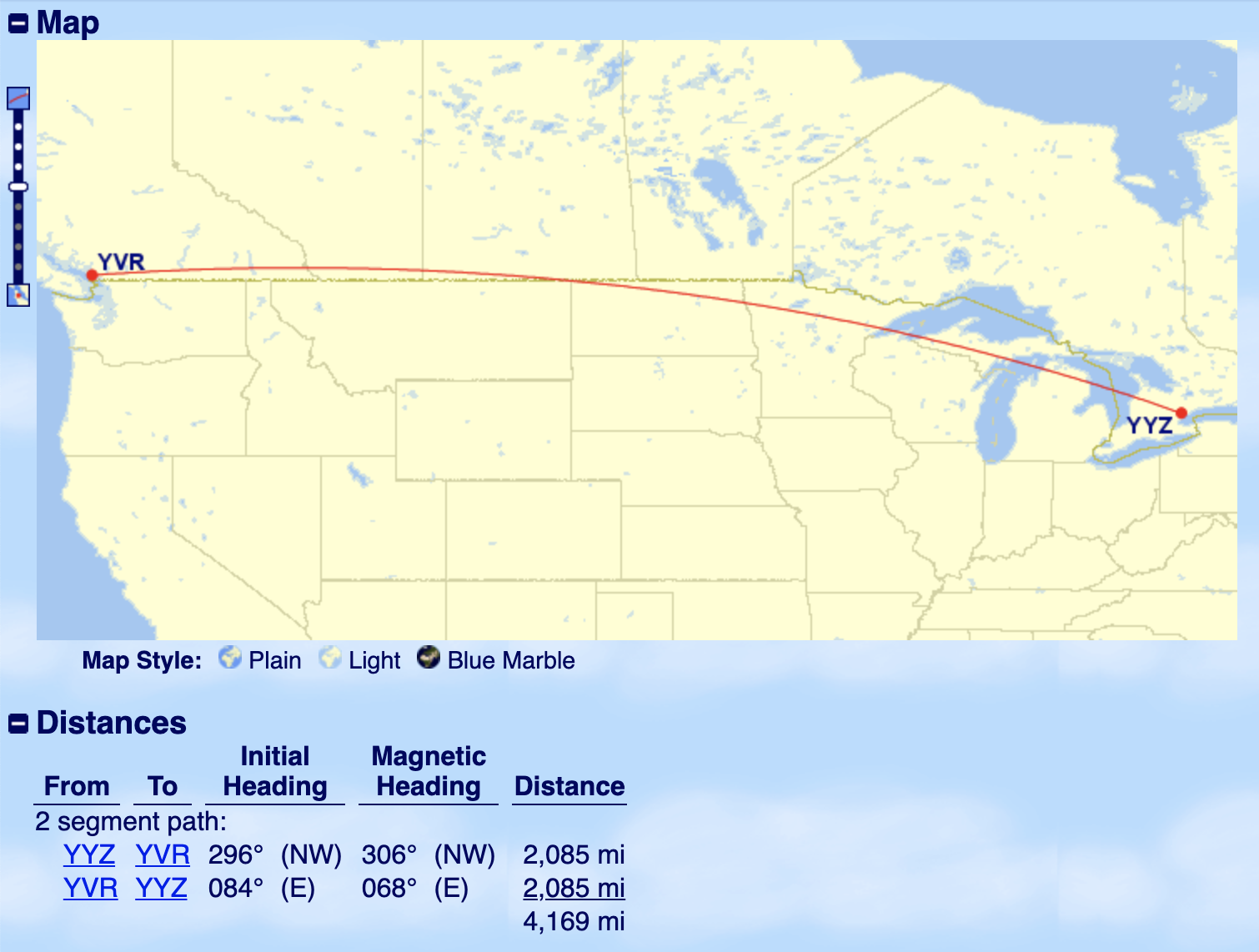
However, if we assume a $700 Flex fare, then you’ll only be earning 700 × 3 = 2,100 Aeroplan points at the base rate.
For most travellers, the earning rates on paid Air Canada tickets will be much lower going forward, especially if you’re budget-conscious and would like to minimize your fare in the first place.
Overall, we can safely say that the change to flight earning rates is a very negative change within the new Aeroplan. It’s a good thing most of us earn our Aeroplan points via sources other than flying, isn’t it? 😉
Loser – Inflexible Travellers
Flexibility is key in Miles & Points. How many times have you heard that one?
Ultimately, the members for whom the new Aeroplan program will be the most disappointing are those who are either unable or unwilling to change their behaviour to minimize the impact of impending devaluations and adapt to the new program’s strengths.
If you’ve only ever redeemed your Aeroplan miles on a route that’s getting severely devalued, maybe it’s time to look into other destinations that might tickle your fancy.
If you’ve only ever taken multi-segment runs to Perth with long layovers for a fixed price of 160,000 Aeroplan miles, maybe it’s time to find a different way to expand your routing possibilities – the stopover on a one-way should certainly help.
And if you’re a Super Elite member who’s always taken pride in maximizing your Priority Rewards for up to 90 passenger bookings every year, maybe it’s time find a different way to maximize the Priority Rewards – and the community has already come up with a few very creative ideas.
Make no mistake – those who are unable to adapt their travel preferences to suit the reality of the new program will find themselves losing out come November 8.
On the other hand, those who keep in mind the mantra of flexibility will find themselves quickly looking past the devaluation of the award chart and searching for all-new ways to come out ahead, turning from Losers into Winners in no time.
Conclusion
The new Aeroplan program has offered up a mix of positive and negative changes compared to the current status quo, so it’s only natural that the reaction among the member base will be mixed as well. While some travellers will rejoice in new sweet spots, opportunities, and conveniences, others will find themselves worse off and will have to adapt their goals with the program accordingly.
What do you make of my picks of the winners and losers with the new Aeroplan? It’s by no means an exhaustive list, so if you think I’ve missed any, feel free to share in the comments below.




















I’m still rather confused with all this. So when I would fly Athens to Vancouver in Business it would cost me 57,000 points. Now it will cost me 85,000 points and from Vancouver back to Athens the same. What am I missing here? This is approximately 60,000 points more…no??
Hi Ricky I just found this site for the first time after a lengthy call with an Aeroplan manager – he actually directed me here for some reassurance that I wouldn’t lose out as much as I thought.
Pacifically, I have about 1 million points that I like to fly business class to Asia 2-3 times per year on points. Sounds like I won’t lose out as much as I had thought (Before I got to the manager the agent told me that way it used to cost 150,000 points to fly to Vancouver to Tokyo and back could go as high as 300,000 after November 8th).
I was so shocked by that I was ready to use up all my points to book flights as far out as they would allow, but now I feel like it’s OK to sit back and see how this unfolds. Please share your thoughts if you think I’m getting this wrong, and thanks again.
Glad to hear it! You are correct – flying to Tokyo will actually be a cheaper use of your points than before, especially if you can get ANA business class. Round-trips for 110,000 points will work out very nicely for you!
As a side note, I find it pretty funny that the Aeroplan managers are directing members here. Hello guys, please sort out the confusion around MPM when booking trips until November 8! 😉
It seems that SE IKK priority awards which we currently have are now gone – so that will be major loss. Yes, we might have the priority vouchers of 50% (but a very limited number) – but if most of the international J class seat I can access on AC – with the increased points requires (similar to Market fare pricing on awards now) is exponentionally more than the minimum – what good it this benefit compared to current IKK? Also how. often would anyone get access to international J class awards on partner airlines? – esp on long haul routes – that is rarely the case now with aeroplan members?
Ricky, with respect to the new program what will the EQM earning percentage be by class?… still 150% for business class?
Correct, SQM earning isn’t changing.
As a SE, this hurts! Especially mileage accumulation flying across the country (100% bonus gone). The multipliers hurt as well since flights are, in my opinion, at an all time low (YHZ – YYT return, 300$). Doesn’t help the SQD. And the limited flight rewards, only for the main traveller, will result in a higher cost to bring your SO. However, I’m hopeful that tweaks can be made with time and the SE community will provide ample feedback.
However, some good feedback for you Ricky! New site is great, and I appreciate all the homework you’ve done on this topic. I couldn’t imagine figuring this out myself 🙂
I would really like if they allowed families to designate a member to receive the Flight segments/miles flown the family. Many members of families often don’t fly anywhere near enough to earn any sort of rank in AC’s loyalty programs. Could simply be a toggle selected by each member, either to keep their own miles and segments or forward them to the selected member or family manager.
But there’s no good reason why someone who flies 4 people 3 times should receive less than a single person who flies solo 4 times. Clearly AC comes out ahead in the former scenario having sold 12 seats. Obviously there would need to be some rules to prevent/limit any abuse.
Interesting thought, Nicolas. Pooling members’ status-qualifying activity, not just redeemable points, would be a significant departure from anything we’ve seen in the loyalty space before. I’d agree that it wouldn’t work with the current “honour system” of Family Sharing and would need to be controlled much more strictly. Maybe submit it as feedback to get it on AC’s radar.
Aye, I haven’t seen anything quite like what I’m suggesting but I think the way they will handle families would work well enough with that idea. I did suggest it after reading another of your post suggesting to give feedback. Left in both in French and English just in case :P.
I may be among the minority of SE who are pleased, depending on the details. Depending on rules on booking multiple bounds on one reward, possible could have 3 return trips per reward at 50% J, each leg priced individually). Also the earning model (apparently still will have ability to select increase points, some estimate would be 11X for SE similar to United) this makes domestic flights significantly more valubale as they are oftern highly priced from a points earning stand point. Devil will be in the details.
Another winner: anyone doing a lot of intra regional flights in Europe, Asia, of the caribbean/US.
Europe’s minimum: 25000 —> 15,000 for under 1000 miles
Asia minimum: 40,000(!) —> 16,000 For under 1000 miles
Caribbean and US: 30,000 —> 12000/20000 on partner flights, for up to 500 and up to 1500 miles respectively.
Add the ability to do stopovers on one ways in Europe and Asia and there are interesting possibilities, assuming availability is decent.
Absolutely. We’ll delve into more of the new sweet spots, including Avios-style short-haul flights around the world, sometime next week.
Great analysis. The bottom line is that, like with any other change in rewards programs, we all need to adapt our strategies to continue to get the most value. Plus ça change.
Oh – and residents of St. John’s are called “Townies.”
Thanks Justin – I knew that somewhere in the back of my mind! Reminds me of the Sims.
On family pooling, are we limited to only redeeming for the members in the family pool are are we still able to book flights for anyone?
On earning points from paid flights. We travel premium economy on most of our long haul flights. So a ticket for $2,000 will net me 8k instead of 17k/21k, quite a difference. I assume we are still allowed to deposit the miles into other star alliance partners (i.e. Asiana)? This is disappointing. AC used to be on the top of my fly list, seems like OW has accelerated to take its place.
You’re still able to book flights for anyone; however, the points would be deducted from all family members’ accounts proportionally to their balances.
Yes, you’ll still be able to credit flights to partners of course. However, you’d need to associate your Aeroplan number with your ticket in order to make use of many of the new credit card benefits (first free checked bag, lounge access, priority services, Status Pass if you’re a recipient, etc.) It’s a tricky tradeoff.
Apparently there are ways to attach one frequent flyer number for the purpose of benefits and another frequent flyer number for the purpose of earning miles, but I’ve never figured this one out myself.
Thanks Ricky, as always, very helpful 🙂
Didn’t think about the tricky tradeoff, points aren’t everything (ha!). I guess AC will remain on my list, just more to consider now when booking flights 😉
Still excited about the new program.
Hmm. So as an Nova Scotian who loves to travel to Europe on a not-so-flexible schedule, I’m potentially the biggest loser out here ! If YHZ-LHR doesn’t return, looks like I can get ALL the way to (wait for it) Amsterdam or Brussels or Paris via YUL >4000mi. Via Toronto ? The Azores…
will there be select privileges upon status, if so do you know what they are?
Yes, Select Privileges will remain. There aren’t many planned changes to it; you can learn about the few changes that are planned here: https://princeoftravel.com/blog/new-aeroplan-elite-status/#privileges
Some privileges may change cosmetically as the new program rolls out, but I’d expect we’ll learn more about this closer to the 2021 status year.
Will we be able to redeem on CX flights finally?
CX flights will still be limited to the few routes between HKG and select destinations in Asia that they are currently.